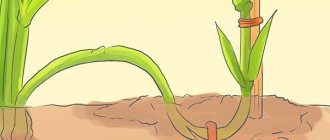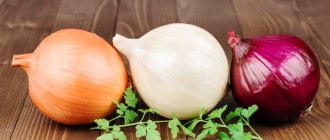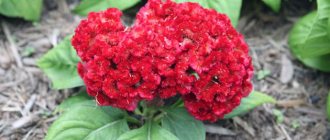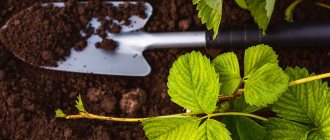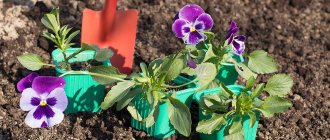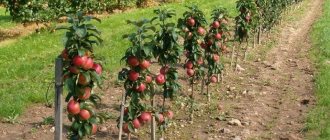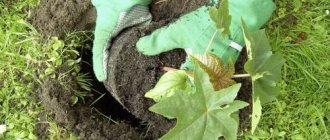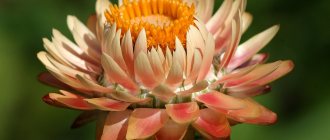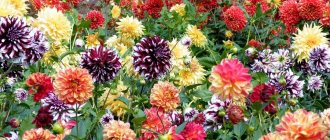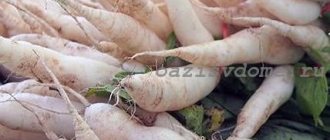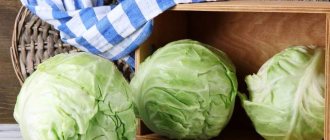Author: Natalya Category: Garden plants Published: January 10, 2019Republished: February 11, 2019Last edits: January 11, 2021
- Soil for pepper seedlings
- Conditions for growing pepper seedlings
Winter has passed halfway through, and the time has come to prepare for sowing seeds for seedlings. What does this preparation involve? You need to purchase seed material, disinfect it and germinate it. The substrate and containers for growing seedlings should also be disinfected before sowing. But the most important thing is to calculate the timing of sowing, that is, choose the most favorable days for this, because the development of seedlings and, ultimately, the quality and quantity of fruits depends on this.
From our article you can find out:
- how to prepare for sowing seeds for seedlings;
- when and how to sow;
- how to care for seedlings;
- how to choose ready-made seedlings.
Whatever line of work you are involved in, it is important for everyone to achieve maximum success in it. In recent years, we have often come across in various fields, including gardening, the concept of favorable or unfavorable lunar days. It was introduced into our everyday life by astrologers, who claim that an enterprise started on a favorable day will be successful, and vice versa, if you start some process on an unfavorable day, the result will most likely be negative.
Recently, more and more people are turning to astrological predictions, and the point here is not in superstition, but in a scientific approach, because the influence of the phases of the Moon on all life on Earth has long been known. This also explains the reasons for the popularity of lunar sowing calendars among gardeners.
- How to plant Brugmansia in the ground (video)
When to plant pepper seedlings in 2021 according to the lunar calendar
The lunar calendar is compiled in such a way as to take into account the most suitable days for planting various vegetables. Thus, the phases of the moon affect the growth of plants and their resistance to pests and diseases, as well as the growth of vegetable crops in general.
Planting at the right time, depending on the phase of the moon, will help the vegetable adapt better and receive more nutrients from the soil.
To plant pepper seedlings, it is recommended to take into account the beginning or middle of February, because it will be possible to plant them in a permanent place in the ground only in March if the climate is suitable.
Lunar phases affect the root system of all vegetation: for sowing seeds, it is recommended to focus mainly on the growing moon. At this time, plant growth is activated, so any planting work can be carried out.
You can also prepare and cultivate the soil, fertilize vegetable crops, but budding is not recommended.
The new moon is generally not suitable for planting peppers. Plants can lose all their vital energy, so on a new moon you can only prepare and loosen the soil for further sowing.
The full moon, lasting no more than three days, is ideal for hilling and fighting plant pests.
The waning moon is not suitable for planting or replanting plants, since during this period their root system is too sensitive. You can fertilize.
When to plant seedlings in open ground
So our seedlings have grown. Warm days have arrived, which means the time has come for our green wards to move to a permanent place of residence. A prerequisite for this is the heating of the surrounding air to 15 degrees and the complete absence of return frosts. For everyone, this comes at different times, here in the Southern Urals, for transplanting into a greenhouse this date can be considered the second half of May.
This is provided that the seedlings were picked during the growing process. And if the seedlings were grown using the method without picking, the best age at which it takes root most easily is 50-60 days. We wait until this age and then replant, not paying attention to the fact that it is already mid-May and the weather is warm. If mid-May has arrived earlier than 50 days, it is better to harden the seedlings; this will only benefit them.
We look at the optimal planting scheme from the instructions for the variety; as a rule, it is either 40x40 or 30x70; the taller the variety, the greater the distance between the rows. We carry out the transplant on a cloudy day or in the evening. To make it easier to remove the seedling from the container, we pour it well with water, and in order not to damage the root system, we replant it with the entire lump of earth in which it grew.
If the soil level in the seedlings reaches the cotyledon leaves, then we transplant them to the same depth. And if not, we deepen it to the cotyledons. It is impossible to make the level even higher; the stem may crack.
I want to share with you another interesting way of planting seeds for seedlings. It is, of course, different from ours, and it may well be that you will like it even more. Watch and try.
That's all for me. Grow seedlings, and in the following articles I will tell you how to care for peppers in the future so that their harvest always pleases you. Until next time.
Sincerely, Alexander.
Planting pepper seedlings by region
The seeds of this vegetable need to be planted depending on the region: where the climate is milder, planting can begin in early February - this applies to the southern regions of Russia.
Pepper sometimes takes a long time to sprout, so you shouldn’t delay sowing. In the northern regions, sowing can only be done by the end of February. In the Moscow region, it is recommended to focus on planting dates from mid-February to early March.
In the Urals, you can plant seeds from mid-February to March, but it is better to choose early-ripening, low-growing varieties. If sowing is carried out in peat tablets, then the most favorable time for this procedure is from the beginning until March 10.
It is not worth planting later than the middle of March, since the plant may outgrow, bloom and fall off, then you will have to wait another month after planting in the ground for the pepper to bloom again.
Do I need to germinate pepper seeds?
Germination is the phase of transition of seeds from a dormant state to an active period of life. Favorable factors (suitable temperature, sufficient moisture and air) contribute to the rapid awakening of the embryo.
Dry pepper seeds take a very long time to germinate in the soil, so experienced gardeners must soak them. Others go further and begin to germinate seeds. This agricultural technique allows the seed to consume less energy and nutrients during pipping, thereby stimulating the rapid emergence of seedlings. In this case, even those seeds hatch that would not sprout with the traditional method of planting in the ground.
You need to germinate peppers from seeds at home in the following cases:
- a rare variety when every seed counts;
- old seed that needs to be awakened;
- The sowing time has passed and the germination process needs to be accelerated.
If the grains are fresh, there are a lot of them, and the planting time has not been missed, then the procedure can be skipped and limited to soaking. This will awaken the embryos and help the seedlings sprout faster.
In any case, in order for the crops to germinate quickly and smoothly, it is necessary to carry out the correct procedures to speed up the pecking of the grains. Whether it is necessary to soak or germinate peppers before planting, each gardener decides for himself.
Sowing pepper seeds by variety
Late-ripening varieties are extremely unsuitable for the northern regions of Russia, because in short summer conditions the pepper may not have time to ripen. Late ripening plants need 4-5 months to fully mature.
Early ripening or early ripening varieties can be safely chosen for planting, as they produce a harvest in about three months. But it is also worth considering that foreign selection is very capricious to the climate, so it is better to buy local seeds.
Hybrid varieties (marked F1) are not suitable for further seed harvesting and do not inherit the characteristics of the variety. The most popular hybrids are: “Alyonushka”, “Maxim”, “Isabella”, “Atlantic”, etc.
The mark F1 is added to the variety name, indicating that these are first generation hybrids. Although they are not suitable for preparing seeds, it is the hybrids that are more resistant to diseases and pests, have the best yield and good fruits.
If we talk about common varieties of pepper, it is worth noting such as: “Snow White” (early ripening), “Kolobok” (early ripening), “Prometheus” (mid-ripening), “Zdorovye” (early ripening), “Marconi” (mid-ripening), etc. d.
Of the late varieties, the most popular are “Golden Medal” and the hybrid “Nochka” F1.
Why is it necessary to germinate pepper seeds?
Germinating pepper seeds, both bell pepper and bitter chili or flame, is not a mandatory procedure. But it is recommended to sow grains dry into the ground if the seed is of excellent quality or hybrid varieties are selected.
The timing of the appearance of seedlings in the home environment when pepper is pre-germinated and when using dry seed material is the same - the first seedlings will appear in approximately 1-1.5 weeks. But there are a number of situations when it is necessary to use only pre-sprouted grains:
- low quality of seed material, which affects the likelihood of germination;
- the seed has expired;
- the seeds were collected from weak or diseased peppers.
Additional Information! It is recommended to germinate pepper seeds because this is the only method to select viable, strongest specimens of the vegetable, and subsequently get a bountiful harvest.
Favorable days for planting pepper seedlings in 2021
In order to grow a rich harvest, you need to check the calendar and choose a favorable day for sowing pepper seedlings.
So, in 2021, in February, seeds can be planted on the following dates: 4, 12-14, 17, 19, 23, 24.
It is not recommended to plant peppers on February 10, 11, 15, 26, 27.
There are also neutral days for landing: 2, 3, 5, 8, 9, 16, 20-22.
In March, it is best to plant peppers on the following dates: 4, 17-19, 22, 23, 30.
Or choose a neutral date for landing: 2, 3, 7, 26-28, 31.
But you should not plant peppers on the following dates in March: 9-16, 20, 24, 25, 29.
Conditions favorable for germination of sweet pepper seeds
To germinate sweet pepper seeds, they need to create favorable conditions:
- The optimum temperature should be in the range from +25 °C to +30 °C. At lower rates, the seeds will grow slowly; at high temperatures, from +32 °C or more, the seed will die.
- Correct humidity - grains should not be constantly immersed in water, but they should not be allowed to dry out. The material on which the seeds will be placed must be just damp enough so that water does not drip from it when squeezing.
- In order for the seeds to sprout faster, it is recommended to cover the container with them with film or a glass jar to create a greenhouse effect. But without oxygen, the seeds will die, so the shelter must be removed every day for 30-40 minutes for ventilation.
Attention! The seed material is moistened as it dries.
Preparing pepper seeds for sowing
Experts advise pre-preparing seeds, as this will significantly improve their germination. If this is not done, the crop may not sprout or sprout in minimal quantities.
Conventionally, all preparatory work can be divided into several stages: seed selection, disinfection, saturation with useful elements, soaking and heating of seeds.
First you need to select the best seeds. To do this, you need to remove the small and large ones, leaving only the medium size.
Next, they need to be placed in a saline solution to see which ones are empty. The saline solution for the procedure is prepared as follows: take boiled or filtered water at room temperature, add a tablespoon of salt to it.
Leave the seeds for about five minutes, then see which ones float on the surface of the water. They are empty - they are not suitable for sowing.
Next, you need to disinfect the seeds in a weak solution of potassium permanganate. You can keep them in the solution for no more than 15 minutes. Then remove them from the solution, rinse and dry naturally. This method makes future seedlings resistant to disease.
The next procedure is to prepare a solution with microelements and soak seeds for seedlings in it. Not all gardeners do this procedure; it is not considered mandatory. But with this method the seedlings will be healthy.
The solution is prepared in this way: you need to take half a liter of water and ten grams of wood ash, mix and leave for 24 hours. Next, the seeds, wrapped in gauze, are immersed in this solution for 4-5 hours, then dried in the usual way.
The penultimate stage is soaking the seeds of future seedlings. To do this, they are created in a humid environment and left in this state for at least a week.
A wet washcloth works well: the seeds are laid out on it, covered on top, and over the next few days you need to make sure that the washcloth remains wet.
If the temperature is optimal (it should be 25-27 degrees in the room with the seeds), then after a week they will begin to hatch. Sometimes the process takes up to two weeks.
Finally, the last stage is hardening. Many gardeners believe that this way the seedlings will better adapt to temperature changes.
Hardening is carried out at a temperature of -1 degree. Overnight, the seeds should be left in any place with a suitable temperature. After this they will be ready for planting.
Caring for pepper seedlings at home
Conditions for growing pepper seedlings
Maintaining the temperature regime necessary for the development of pepper seedlings in an apartment is not so easy, but you should know that near the ceiling the air temperature is a couple of degrees higher than at the average height, and near the baseboard it is two to three degrees lower. The brightest place in the apartment is the window sill, but it is also the coldest, and seedlings need warmth.
- Lovage: cultivation, properties, types
If you can provide artificial lighting for the seedlings, you can grow them where they will be warmer.
At a temperature of 26-28 ºC, pepper seeds germinate on the eighth to twelfth day, at a temperature of 20-26 ºC, shoots can appear after 13-17 days, at 18-20 ºC - after 18-20 days, and at 14-15 ºC you can wait for the emergence of seedlings no earlier than in a month.
As soon as the seedlings appear, the crops are moved as close to the light as possible, the temperature is lowered for a week to 15-17 ºC, and subsequently the seedlings are kept at 22-25 ºC during the day and at 20 ºC at night.
Do not forget to regularly ventilate the room, but keep in mind that seedlings are afraid of drafts and cold air.
Watering pepper seedlings
For the first two or three days, the emerging seedlings are not watered, but if the soil requires moisture, it is carefully sprayed with a sprayer. As soon as the cotyledon leaves open, the seedlings are watered with thirty-degree water. Subsequently, the seedlings are moistened with rain or tap water at room temperature that has been left standing for 24 hours.
The soil of the seedlings should not dry out - pepper does not tolerate drought, but excess moisture in the roots should not be allowed.
Please note that soil in a shallow container loses moisture faster than in a large container. Air humidity in the room is maintained at 60-70%.
Feeding pepper seedlings
To develop the root system of seedlings, they are fed with potassium humate, diluting 5 ml of the drug in two liters of water. Before the formation of flower buds, pepper seedlings develop very slowly, then their growth becomes more intense, and during the flowering period, pepper seedlings are fertilized with the following composition containing microelements: 1 g of manganese sulfate and iron sulfate or citrate are dissolved in 10 liters of water, 0. 2 g of zinc sulfate and copper sulfate and 1.7 g of boric acid.
Pinching pepper seedlings
Homemade pepper seedlings require pinching, that is, removal of the growing point of the seedlings. This is done in order to stimulate the development of the root system in the peppers and the growth of stepsons from dormant buds in the internodes in which flowers are formed.
How to grow strong and healthy tomato seedlings
Pinching is done when the bell pepper seedlings begin to develop intensively - the part of the plant located above 4-6 internodes is removed with scissors. When, over time, the seedlings begin to grow stepchildren, the load on the bush is regulated, leaving 4-6 of the most developed stepchildren, and the rest are removed. There is no need to remove stepsons in the lower internodes.
Illumination of pepper seedlings
Since peppers have a longer growing season compared to other vegetable crops, seedlings of this crop begin to be grown earlier than other plants, when daylight hours are still short. But due to the fact that pepper seedlings require lighting for 12-14 hours every day, it is necessary to organize artificial lighting for it, otherwise the seedlings will be thin and elongated, with sparse leaves due to too long internodes.
Natural light from February to March is only about 5,000 lux, but normal seedling development requires a light level of 20,000 lux. The process of photosynthesis requires not just light, but a certain spectrum of rays: red rays stimulate the process of seed germination and flowering of seedlings, violet and blue rays participate in the formation of cells, while yellow and green rays do not affect the development of plants. Namely, yellow light is emitted by ordinary incandescent lamps, and therefore it makes no sense to use them to illuminate seedlings. In addition, such lamps emit infrared rays, which cause the seedlings to stretch and overheat.
It is best to use phyto- or fluorescent lamps for artificial illumination of pepper seedlings, as well as LED lamps, which are created specifically for such purposes. The seedlings are illuminated with 200 W lamps per 1 m² of crop area. The lighting is placed at a distance of 20 cm from the tops of the plants, and when the seedlings grow, the light source is raised.
In the development phase of cotyledon leaves, to stimulate rapid growth of seedlings, lamps should be operated for three days in a row. As soon as the seedlings have true leaves, the daylight hours should be 14-16 hours. In February, artificial lighting should work from the morning until 19-20 hours without interruption. In April, the lights are turned on only in the mornings from 6 to 12 hours and in the evenings from 16 to 19 hours.
Picking pepper seedlings
If the pepper grows in a common container, at the stage of development of the seedlings with two true leaves, the seedlings are picked, although some reference books recommend picking already in the cotyledon phase. The soil with seedlings is well moistened, after which excess water is allowed to drain. Seedlings are planted in separate pots with a capacity of 100-150 ml - the seedlings, together with a lump of earth, are transferred into holes made in the soil, which should accommodate the root system of the seedling with soil. The roots are placed freely in the soil, without bends. The hole is sprinkled with soil and lightly compacted.
When picking, the root collar of the seedlings is buried no more than 5 mm. After transplanting, the seedlings are watered and, if necessary, soil is added to the pots. At first, the seedlings are protected from direct sunlight, and the temperature should not be lower than 15 ºC - at 13 ºC, seedling growth stops.
Planting rules and soil preparation for planting
To plant pepper seedlings, a mixture of soil with peat and sand is usually made. To do this, take soil in two parts and one part each of peat and sand. Next, fertilizer (purchased or prepared independently) is added to the soil.
If you prepare your own fertilizer, you need to take urea (half a teaspoon) and 2.5 ml. potassium humate, add all this to a liter of boiled or filtered water at room temperature. This is the very first fertilizer for pepper seedlings.
If you don’t want to prepare the soil yourself, you can buy a universal soil soil at a gardening store and add a little wood ash to it.
Many gardeners heat the soil in the oven to rid it of roots or insects that could later harm the seeds or plants.
You need to plant pepper seeds in shallow holes (up to one and a half centimeters), then sprinkle them with soil and sprinkle the ground with water from a spray bottle. If planting is done in one common container, then a distance of at least three centimeters must be maintained between the seedlings.
Both containers and ordinary plastic cups are suitable for planting seeds. The easiest way to sow is in peat tablets.
The container where the seeds will be planted must have well-thought-out drainage: gravel or egg shells are suitable for this, which is also considered a top dressing.
How to test seeds for germination
Before germinating peppers, it is recommended to check the quality of seeds collected independently or purchased in a store. This can be done in two ways:
- Lay out the grains on the table, select the largest specimens without visible signs of damage. The larger the seeds, the stronger they are, the higher their potential.
- Pour the grains with water in a glass or jar. You need to take those that sink to the bottom. Hollow specimens will rise to the surface of the water.
If all the seeds have risen to the surface of the water, this does not mean that all the seed is unsuitable, since the water test does not give a 100% guarantee. In this case, it is worth choosing the largest specimens and working with them.
The water test, despite the possible error, is one of the most effective
How to care for seedlings before transplanting into a greenhouse
At first, it is advisable to cover the container with seedlings with cling film and place it on a radiator or in another warm place. It's a kind of greenhouse. When the first shoots appear, the seedlings should begin to be illuminated with a regular lamp or phytolamp.
Watering can be done with warm tap water, which has previously settled. There should be no shortage or excess of water.
When the seedlings have 3 true leaves, you can make a pick. After picking, the soil is watered with water or a weak solution of potassium permanganate.
It is not recommended to keep the seedlings in sunlight after picking - they must adapt to the new environment for a couple of days.
Next, you need to water the plants not often, but abundantly. Before planting peppers in a greenhouse, it is recommended to carry out a hardening procedure.
Feeding seedlings and hardening
Hardening is necessary so that the root system of seedlings becomes more powerful. To do this, 2-3 weeks before planting in a permanent place, the seedlings are exposed to the open sun, first for a small amount of time, but gradually increase the time.
To do this, you can place them on the balcony or open a window.
A week or a week and a half before planting in open ground, the seedlings are fed a second time.
To do this, for 5 liters of water take: 5 grams of ammonium nitrate, 7 grams of potassium sulfate and 13 grams of superphosphate.
If the fertilizer gets on the leaves of the seedlings, you will need to rinse them with plain water at room temperature.
When to transplant pepper seedlings into a greenhouse
You can start planting seedlings in the greenhouse from May 20. Before doing this, it is recommended to preheat the soil. If night temperatures are still low, then it is worth taking care of additional film cover for plants.
Seedlings can be transplanted into a greenhouse when the stems are 15 to 25 centimeters high and have at least 10 true leaves.
But the most important thing is to know when to plant pepper seedlings in 2021 in order to plant them in open ground and get a good harvest in the fall. Have a great harvest everyone, good luck!
Diseases of bell pepper seedlings
Pepper is a rather capricious garden crop, and problems that arise with it are typical for most nightshades.
Blackleg
Mainly manifests itself in early seedlings. It looks like yellowing of the stem near the soil, then blackening of the stem, the plant dries out and dies.
Late blight
This disease has the same origin, fungal. Brown spots appear on the leaves and stem, they gradually increase in size and the plant dies. The reason may be low temperatures and high humidity.
Powdery mildew
This is also a fungus. Looks like a powdery coating on the leaves. Subsequently, the leaf turns yellow, the stem dries out, and plant growth slows down.
Gray rot
This fungus looks like gray fluff.
The main pests of pepper include spider mites and aphids. These insects live in the axils of leaves and on their reverse side. If possible, diseased plants should be isolated from healthy ones and also treated with antiseptics.
Pulling seedlings
This often happens when the pepper does not have enough light. What to do: add light sources or lower the temperature. At low temperatures, the plant will grow slower and straighten its height to normal.
The seedlings don't bloom
This happens if there is an imbalance of fertilizers. For example, peppers are overfed with nitrogen. Or the conditions of detention - temperature, light and humidity - are violated. What to do: normalize the conditions for keeping pepper and reduce the amount of fertilizer.
We must remember that infection with fungal diseases occurs mainly from the containers, soil and tools used. They must be thoroughly treated with fungicides before planting and during pepper care.
Now you know when to plant bell pepper seedlings and how to provide them with proper care, so that by the end of summer you will have a fragrant, healthy vegetable grown in your own garden on your table.
